Early & Classic US Dollars
Flowing Hair Dollars, 1794-1795
On July 6, 1785, the United States established its own standard monetary unit. Since Americans were used to the Spanish dollar (or Piece of Eight) that had circulated in the original colonies, the new currency was named the "dollar". The first U.S. Mint building began operations in Philadelphia in 1793, and the first silver dollar appeared the following year – the Flowing Hair dollar of 1794-95. According to the official mint report, just 1,758 dollars were struck the first year. It's been said that some had expressed interest in portraying President George Washington on the first U.S. silver dollar, but Washington didn't like that idea, feeling that it emulated coins of the British royalty.
Draped Bust Dollars, 1795-1804
In 1795, the Draped Bust dollar replaced the Flowing Hair coinage. Its reverse design remained similar to the one on the Flowing Hair dollar until 1798, when it was changed to a heraldic eagle until the end of the series (in 1804). These coins represent a remarkable era in American dollar history. Since precious silver ore was scarce, dollars of that period have very low mintages.
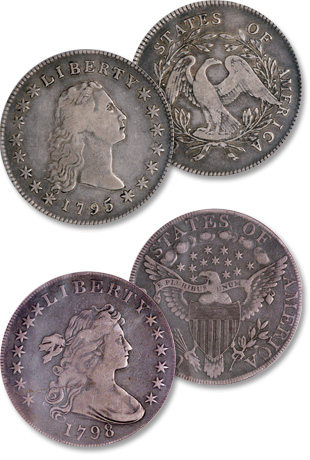
Flowing Hair and Draped Bust dollars were the first silver dollars struck by the U.S. Mint during the nation's early years.
Gobrecht Dollars, 1836‑1839
American dollar history paused at the end of the Draped Bust series in 1804, and did not start again until the start of the Gobrecht dollars in 1836. Issued just three years, the Gobrecht dollars of 1836-1839 (no coins were issued bearing the 1837 date) are one of America's rarest and shortest-lived silver dollars. The design was executed by U.S. Mint engraver Christian Gobrecht, based on sketches by Thomas Sully and Titian Peale. His inscription C. GOBRECHT F. is on the obverse, at the base of Liberty, who is seated holding a shield and a capped pole. The F. in his inscriptions an abbreviation of the Latin word Fecit, which translates to "made it". A large eagle is shown flying on the reverse.
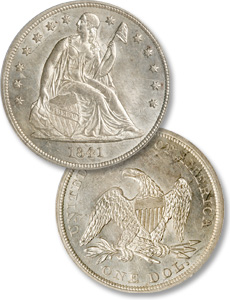
The early Liberty Seated dollar design did not include the motto IN GOD WE TRUST.
Liberty Seated Dollars, 1840‑1873
Liberty Seated silver dollars were introduced in 1840. Bearing the obverse design created earlier by U.S. Mint engraver Christian Gobrecht, it depicts Liberty seated on a rock, her left hand holding a liberty cap on a pole, and her right hand resting on a shield inscribed LIBERTY. The reverse design differed from that of the earlier Gobrecht dollars, featuring an eagle clutching an olive branch and arrows. Amid the religious fervor of the Civil War era, the motto IN GOD WE TRUST was added to the reverse in 1866, and continued through the end of the series in 1873.
See our Liberty Seated dollar inventory
Trade Dollars, 1873-1885
By the 1850s, U.S. merchants were intent on expanding trade with the Orient and China. Since Chinese merchants did not accept paper money and didn't like gold, silver coinage was used as an alternative. At this time in dollar history, the Comstock Lode had yet to be discovered, and mintage of Liberty Seated dollars was not sufficient to export quantities to the Orient. Instead, U.S. merchants needed to buy Spanish-American 8 Reales ("milled dollars") at a premium from Mexico.
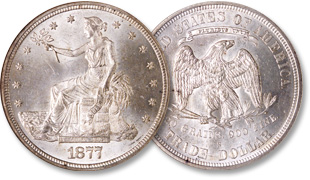
Short-lived U.S. Trade dollars contained more silver than regular-issue dollar coins.
As a result, Congress authorized special coins – Trade dollars. Liberty was shown seated on the obverse, holding out an olive branch toward the sea, welcoming peaceful international trade. The reverse depicted an eagle, along with the weight and purity of these new coins: 420 GRAINS 900 FINE. Because these coins were unfamiliar in the Orient, counterfeiters soon began to take advantage. As a result, the Chinese government required merchants to guarantee the purity of U.S. Trade dollars. Each merchant would stamp a unique symbol onto the coin, known as "chop marks". (Read more: Chop Marked Trade Dollars)
In all, 36 million Trade dollars were minted, and more than 27 million of those were sent to the Orient. Because of their high silver content, most were eventually melted down overseas, and their silver used for other purposes. By 1876, the circulation of Trade dollars in America was no longer desirable, so Congress removed their legal tender status (the first time in American dollar history a U.S. coin had been demonetized).
See our Trade dollar inventory
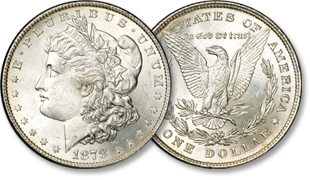
Classic Morgan dollars of 1878-1921 are named for their designer George T. Morgan
Morgan Dollars, 1878‑1921
Big, hefty and 90% silver – the Morgan dollar series is one of America's most popular collectibles. Please visit our special section on Morgan Silver Dollars to learn about these exciting and historic coins.
See our Morgan dollar inventory
Peace Dollars, 1921-1935
America added another chapter to U.S. dollar history as troops began returning home after World War I. Many nations adopted symbols of peace, and the United States chose to honor peace on the silver dollar. The design was selected from a competition among the top medalists of the era. An Italian immigrant named Anthony de Francisci, who modeled his obverse portrait of Liberty after his young wife, Teresa. (Read more: Peace Dollar model had special claim to fame)
The new design symbolized the end of wartime bitterness and the start of a future dedicated to peace. It shows Liberty wearing a spiked headdress similar to that found on the Statue of Liberty. On the reverse, an American eagle is shown facing the new dawn, with the word PEACE inscribed below. Following the end of the series in 1935, U.S. dollar history was put on hold once again, until the debut of the Eisenhower coinage in 1971. Few dollar coins were saved during the Great Depression, and many Peace dollars were lost to silver melts over the years. The scarcity of these coins, combined with their remarkable beauty, has made them a favorite with collectors.
See our Peace dollar inventory
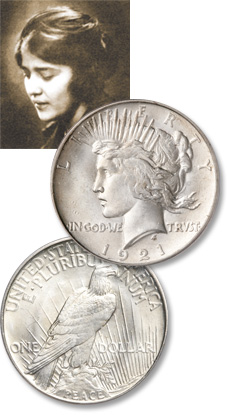
The portrait of Liberty on the Peace dollar's obverse was modeled after designer Anthony de Francisci's wife, Teresa.

